Next: Annotated Parameter Files
Up: Using IWAVE
Previous: Acknowledgements
-
Brown, D., 1984, A note on the numerical solution of the wave equation with
piecewise smooth coefficients: Mathematics of Computation, 42,
369-391.
-
-
Cohen, G. C., 2002, Higher order numerical methods for transient wave
equations: Springer.
-
-
Fehler, M., and P. J. Keliher, 2011, SEAM Phase I: Challenges of
subsalt imaging in tertiary basins, with emphasis on deepwater gulf of
mexico: Society of Exploration Geophysicists.
- (eISBN=9781560802884, eBook catalog number 114E).
-
Fomel, S., 2009, Madagascar web portal: http://www.reproducibility.org,
accessed 5 April 2009.
-
-
Levander, A., 1988, Fourth-order finite-difference P-SV seismograms:
Geophysics, 53, 1425-1436.
-
-
Moczo, P., J. O. A. Robertsson, and L. Eisner, 2006, The finite-difference
time-domain method for modeling of seismic wave propagation: Advances in
Geophysics, 48, 421-516.
-
-
Muir, F., J. Dellinger, J. Etgen, and D. Nichols, 1992, Modeling elastic
fields across irregular boundaries: Geophysics, 57, 1189-1196.
-
-
Symes, W. W., D. Sun, and M. Enriquez, 2011, From modelling to inversion:
designing a well-adapted simulator: Geophysical Prospecting, 59,
814-833.
- (DOI:10.1111/j.1365-2478.2011.00977.x).
-
Symes, W. W., and T. Vdovina, 2009, Interface error analysis for numerical
wave propagation: Computational Geosciences, 13, 363-370.
-
-
Terentyev, I., and W. W. Symes, 2009, Subgrid modeling via mass lumping in
constant density acoustics: Technical Report 09-06, Department of
Computational and Applied Mathematics, Rice University, Houston, Texas, USA.
-
-
Terentyev, I., T. Vdovina, X. Wang, and W. W. Symes, 2012, IWAVE: a
framework for wave simulation:
http://www.trip.caam.rice.edu/software/iwave/doc/html/index.html, accessed 21
Sept 2012.
-
-
Virieux, J., 1984, SH-wave propagation in heterogeneous media: Velocity
stress finite-difference method: Geophysics, 49, 1933-1957.
-
-
----, 1986, P-SV wave propagation in heterogeneous media: Velocity
stress finite-difference method: Geophysics, 51, 889-901.
-
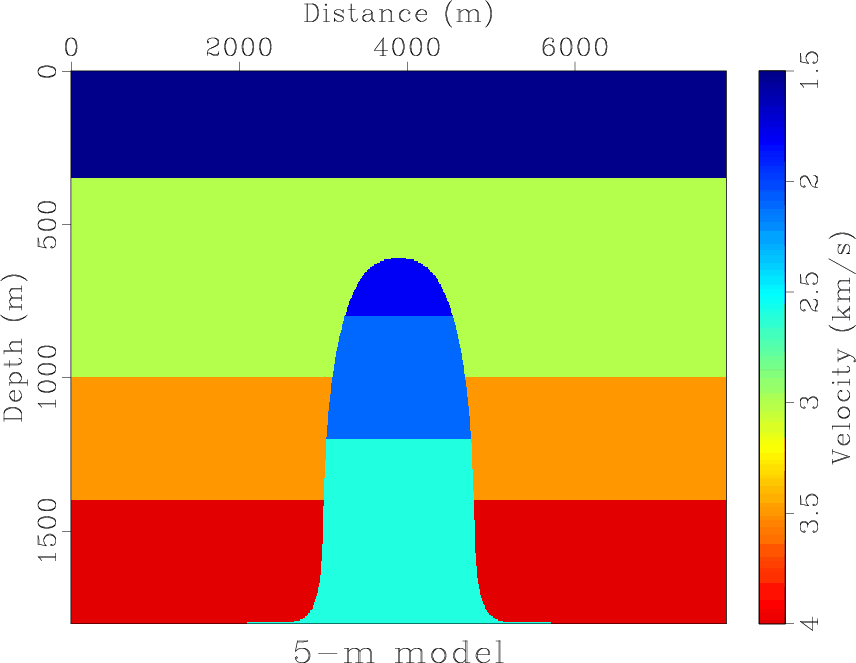
|
|---|
vp1
Figure 1. Dome velocity model
|
|---|
![[pdf]](icons/pdf.png) ![[png]](icons/viewmag.png) ![[scons]](icons/configure.png)
|
|---|

|
|---|
dn1
Figure 2. Dome density model
|
|---|
![[pdf]](icons/pdf.png) ![[png]](icons/viewmag.png) ![[scons]](icons/configure.png)
|
|---|

|
|---|
data1
Figure 3. 2D shot record, (2,4) staggered grid scheme,
 5 m,
appropriate 5 m,
appropriate  , 301 traces: shot x = 3300 m, shot z = 40 m, receiver x =
100 - 6100 m, receiver z = 20 m, number of time samples = 1501, time
sample interval = 2 ms. Source pulse = zero phase trapezoidal [0.0,
2.4, 15.0, 20.0] Hz bandpass filter. , 301 traces: shot x = 3300 m, shot z = 40 m, receiver x =
100 - 6100 m, receiver z = 20 m, number of time samples = 1501, time
sample interval = 2 ms. Source pulse = zero phase trapezoidal [0.0,
2.4, 15.0, 20.0] Hz bandpass filter.
|
|---|
![[pdf]](icons/pdf.png) ![[png]](icons/viewmag.png) ![[scons]](icons/configure.png)
|
|---|

|
|---|
trace
Figure 4. Trace 100 (receiver x = 2100 m) for
 20 m (black), 10 m (blue), 5 m (green), and 2.5 m (red). Note
arrival time discrepancy after 1 s: this is the interface error
discussed in (Symes and Vdovina, 2009). Except for the 20 m result,
grid dispersion error is minimal.
20 m (black), 10 m (blue), 5 m (green), and 2.5 m (red). Note
arrival time discrepancy after 1 s: this is the interface error
discussed in (Symes and Vdovina, 2009). Except for the 20 m result,
grid dispersion error is minimal.
|
|---|
![[pdf]](icons/pdf.png) ![[png]](icons/viewmag.png) ![[scons]](icons/configure.png)
|
|---|
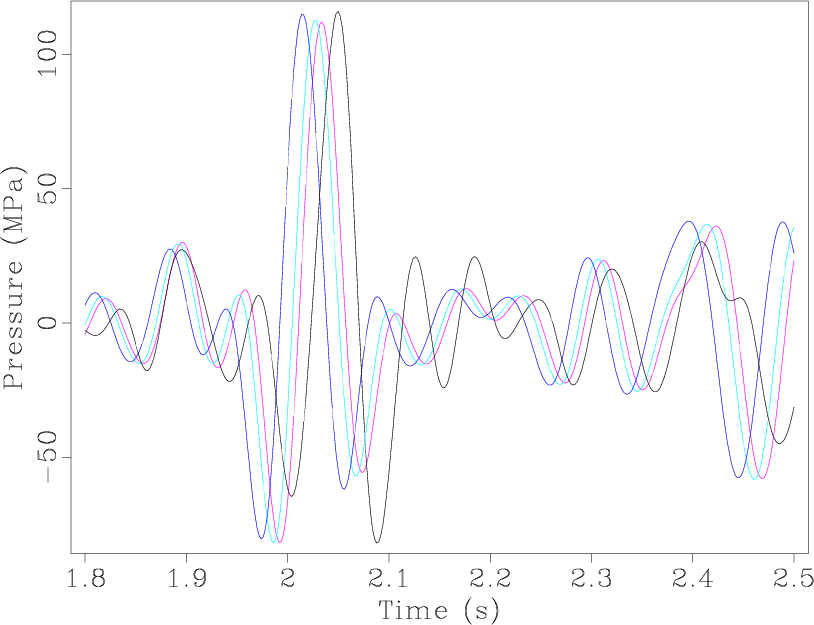
|
|---|
wtrace
Figure 5. Trace 100 detail, 1.8-2.5 s, showing more clearly the
first-order interface error: the time shift between computed events
and the truth (the 2.5 m result, more or less) is proportional to
 , or equivalently to , or equivalently to  . .
|
|---|
![[pdf]](icons/pdf.png) ![[png]](icons/viewmag.png) ![[scons]](icons/configure.png)
|
|---|
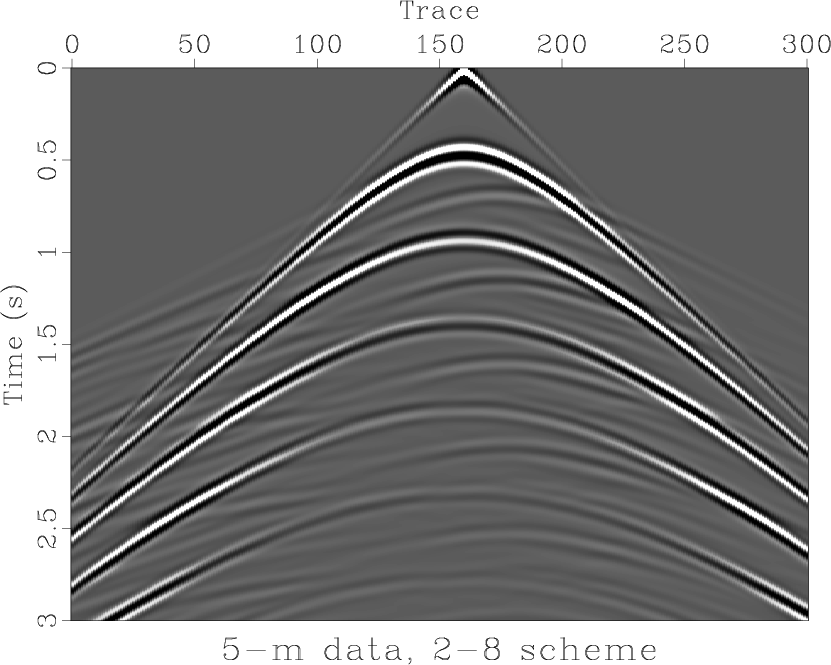
|
|---|
data8k1
Figure 6. 2D shot record, (2,8) scheme, other
parameters as in Figure 3.
|
|---|
![[pdf]](icons/pdf.png) ![[png]](icons/viewmag.png) ![[scons]](icons/configure.png)
|
|---|
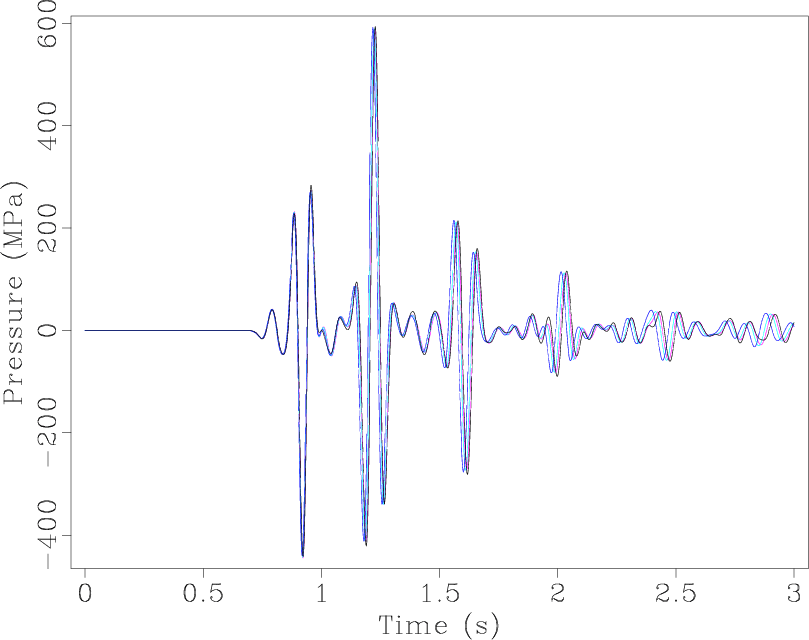
|
|---|
trace8k
Figure 7. Trace 100 computed with the (2,8) scheme,
other parameters as described in the captions of Figures
3 and 4.
|
|---|
![[pdf]](icons/pdf.png) ![[png]](icons/viewmag.png) ![[scons]](icons/configure.png)
|
|---|
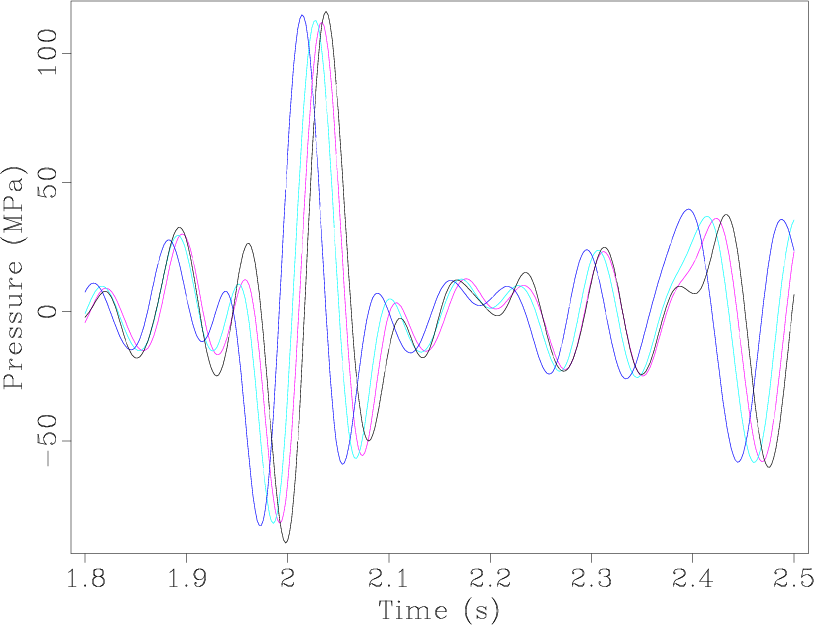
|
|---|
wtrace8k
Figure 8. Trace 100 detail, 1.8-2.5 s, (2,8) scheme..
Comparing to Figure 5, notice that the dispersion error for
the 20 m grid is considerably smaller, but the results for finer grids
are nearly identical to those produced by the (2,4) grids - almost all
of the remaining error is due to the presence of discontinuities in
the model.
|
|---|
![[pdf]](icons/pdf.png) ![[png]](icons/viewmag.png) ![[scons]](icons/configure.png)
|
|---|
Next: Annotated Parameter Files
Up: Using IWAVE
Previous: Acknowledgements
2012-10-17







